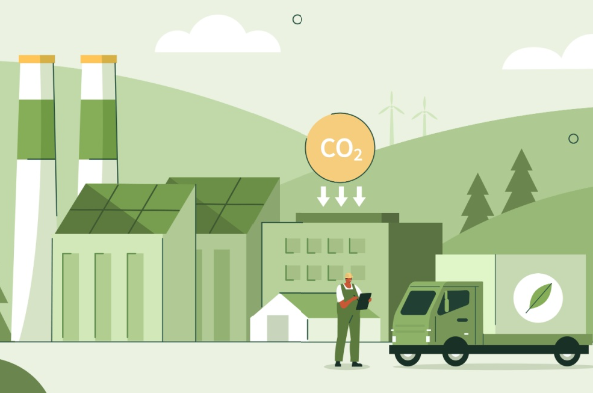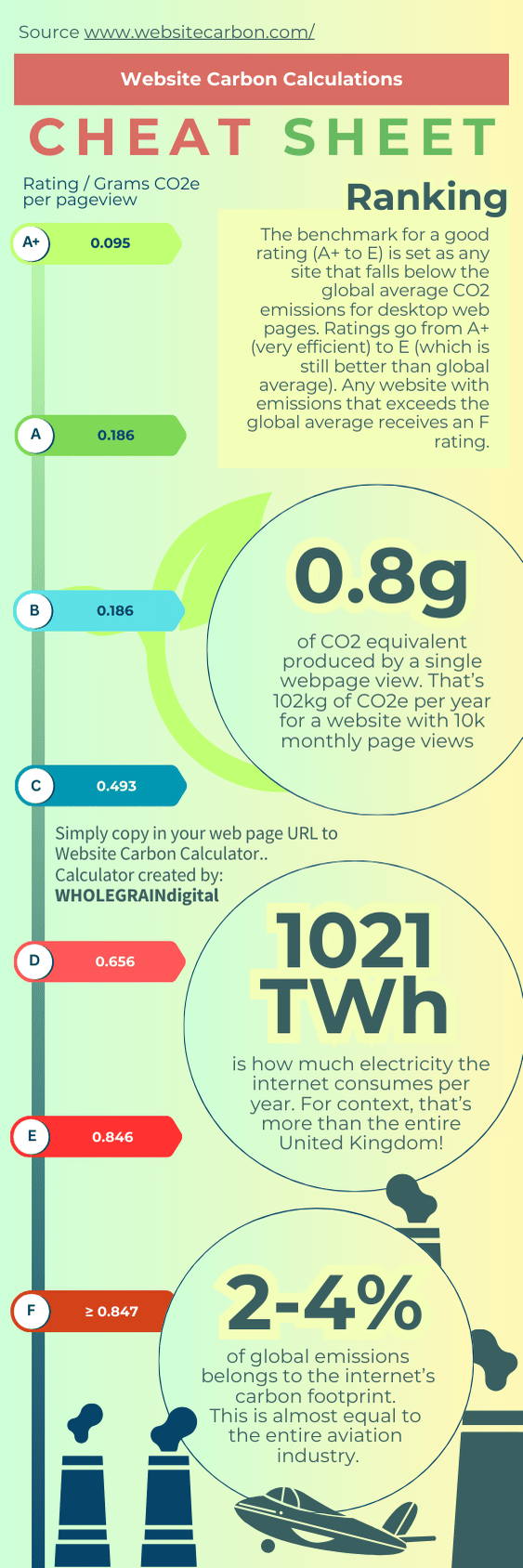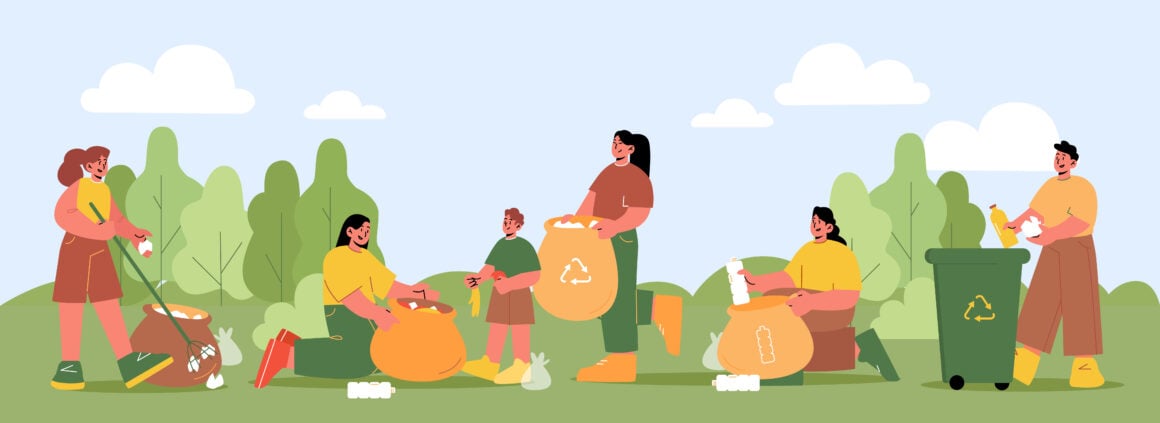Sustainable website development: how to determine the sustainability of your website
With the growing concerns around climate change, prioritising sustainable website development is more important than ever. Read on to find out how much carbon your website is emitting, and how to improve your website sustainability.

Index
- What is sustainable website development? An introduction
- How to check if my website is sustainable?
- Sustainability ranking: what is used to estimate a rating?
- Sustainable website design examples: check carbon emissions for different websites
- How to improve your carbon rating?
- BrightMinded’s commitment to sustainability
- Conclusion
TL;DR summary:
- Websites produce carbon emissions through data centres, networks, and user devices, making sustainability increasingly important.
- Tools like WebsiteCarbon and EcoGrader help measure your site’s carbon footprint and identify areas for improvement.
- High emissions often come from unoptimised media, heavy content, and non-green hosting.
- Sustainable practices, like efficient coding, image optimisation, and green hosting, reduce emissions and improve SEO and site performance.
- Sustainability is an ongoing effort that strengthens brand reputation and supports broader climate action.
What is sustainable website development? An introduction
As awareness of climate impact grows and global trends gain momentum to promote sustainability, it is crucial to ensure that your website is as sustainable as possible.
Embracing greener software has become an imperative when promoting your brand to new clients. Many consumers, prioritising climate action, prefer to engage with companies committed to improving sustainability and staying informed on reducing environmental impact.

Environmental organisations have been trying to raise awareness surrounding the issues caused by climate change. They have been advising companies on the steps they can take to minimise their environmental footprint through sustainable online practices.
By ensuring that your company transitions to greener software, not only will your team be helping the planet as a whole, but you will also attract more clients by creating value and boosting engagement for your website.
Acknowledging the impact of carbon emissions and the effects a lack of environmental awareness impose onto the atmosphere, is the first step in realising that your business needs a branding reevaluation and a website upgrade.
This article follows up on the ways you can adopt sustainable website development practices to reduce carbon emissions and improve your environmental impact. We detail how to assess your website’s carbon emissions and suggest changes for a more sustainable future.
How to check if my website is sustainable?
Greenhouse gas emissions are produced by a range of industries, including transportation and the residential sector; all of which contribute to trapping heat within the atmosphere. The use of websites, apps, and software are a part of this mainly due to the consumption of energy from data centres, which are used for powering websites.
With climate change escalating, and the lack of awareness many companies have surrounding their online presence, businesses should want to align with eco-friendly values. By promoting climate action on your website, you can help to encourage others to take part in sustainable web development as well.
Understanding the environmental impact of website energy consumption is critical. While data centres are necessary for business operations, as being online attracts more clients, steps can be taken to reduce electricity usage and to improve the state of the environment.

Organisations like WebsiteCarbon, EcoGrader, and the Green Web Foundation, provide tools based on their own databases, to estimate your website’s carbon emissions. By accessing these resources, it can help you gauge your platform’s sustainability.
Here’s how to calculate your website’s carbon emissions:
- Visit a website like WebsiteCarbon They offer a carbon footprint calculator, which provides you with the results of your website’s carbon ranking.
- All you need to do is enter your web page address into the calculator. Any public website available through a standard web browser can check their carbon footprint.
- The tool will analyse your website and provide a ranking based on various metrics such as:
- A letter grade from A+ to F.
- A comparison percentage of your website with other web pages globally.
- The amount of carbon produced whenever someone visits your web page.
- Whether your website uses sustainable, green energy.
- Equivalents to everyday activities, such as cups of coffee poured, average phone charges, and bubbles. This generates a better understanding of the amount of carbon being produced.
- The average amount of carbon produced within a year.
These tools are a positive and effective way to highlight the need for online rebranding and provide actionable data to inspire immediate changes that need to happen.
Sustainability ranking: what is used to estimate a rating?

So how do these sustainability organisations calculate your results to estimate the amount of carbon emissions produced from a web page?
The website WebsiteCarbon, uses The Sustainable Web Design Model, which considers sub-systems, key inputs, and different emission categories to estimate digital emissions. This model is a collaboration between organisations and provides a comprehensive approach to calculating carbon emissions, enabling anyone to utilise the results.
The sub-systems included in this model are:
- Data centres: Data centres are the physical facilities used by organisations to house and serve applications and data. Energy is required to run the equipment necessary for this purpose.
- Networks: A network is the link between two or more computers that use an allocation of energy to transfer data and share resources.
- User-devices: End users use energy to interact with a product or service through their device, whether it be a mobile or a desktop device.
By focusing on every point where data is transferred to the user’s device and considering the energy consumed by the previous devices, a more accurate assessment of the carbon emissions released can be achieved. Since any non-renewable energy used in this process generates carbon emissions, it is crucial to look beyond just the origin of the website.
The emission categories used for the model are:
- Operational emissions: The emissions associated with the energy needed for the use of devices in a segment.
- Embodied emissions: The remaining emissions associated with the production of the devices in a segment.
The key inputs used for the results are:
- Data transfer: The amount of data transferred between devices when loading or using content online.
- Carbon intensity: The global average carbon intensity of electricity.
By taking all of this data into account, the model is able to provide a result based on every point at which energy could have been used when creating a website. This approach ensures an accurate estimate of emissions, and is able to promote sustainability effectively.
Sustainable website design examples: check carbon emissions for different websites
These results don’t give the exact areas of your website that bring down, or raise your sustainability rating, but from finding out the statistics of your own carbon emissions, you can analyse your website to work out what needs changing through following a guide on ways that your website can be sustainable.
We used WebsiteCarbon and the Green Web Foundation to calculate the results of brightminded.com, our own website, as well as the website of some of the clients we have worked with, and other large corporations. By calculating the results of different websites, we can see just how sustainable some of the companies online really are. Do you think that larger businesses would take an interest in being environmentally friendly online?
Here are the results of our research:
- brightminded.com: Rank A, cleaner than 84% of all web pages globally, Producing 0.17g of CO2 every time someone visits this web page, Hosted on green energy.
- britishecologicalsociety.org: Rank B, cleaner than 75% of all web pages globally, producing 0.24g of CO2 every time someone visits this web page, hosted on green energy.
- lavazza.co.uk: Rank F, dirtier than 76% of all web pages globally, producing 1.04g of CO2 every time someone visits this web page, not hosted on green energy.
- volkswagen.co.uk: Rank F, dirtier than 96% of all web pages globally, producing 4.07g of CO2 every time someone visits this web page, not hosted on green energy.
- google.co.uk: Rank A, cleaner than 84% of all web pages globally, producing 0.17g of CO2 every time someone visits this web page, hosted on green energy.
- dailymail.co.uk: Rank F, dirtier than 73% of all web pages globally, producing 0.93g of CO2 every time someone visits this web page, not hosted on green energy.
- uk.yahoo.com: Rank F, dirtier than 95% of all web pages globally, producing 3.51g of CO2 every time someone visits this web page, not hosted on green energy.
Website Carbon bases this letter ranking system, for each website, on the global average of CO2 emissions produced for web pages. A rating from A+ to E is considered to be a good rating, and any web page that falls below the global average is given a rating of F.
From calculating these results for different websites, we can see the vast difference in emissions, and which companies are likely aware of their carbon rating. The reasons for a large production of carbon emissions from certain websites, is likely due to an overloaded amount of content which hasn’t been optimised to reduce file sizes, which would therefore reduce emissions.
Large corporations especially, should be taking note of their environmental impact online. They have a larger number of consumers on their website, causing higher traffic, and would produce more carbon in a year than a much smaller company would with the same carbon percentage ranking.
How to improve your carbon rating?
Now that you should have an understanding of your website’s carbon rating, you can take key steps to ensure that your website is more sustainable.
In another article, we discuss some of the methods of implementing green software development practices. These methods included:
- Efficient coding practices
- Optimising images and media for marketing impact
- Choosing green sustainable web hosting
- Reducing energy consumption through smart IT infrastructure
You can read more in-depth on these methods and how to apply them to your own website on our Sustainable websites: how to optimise your website for sustainability blog.
Prioritising sustainable web development doesn’t just lead to the support of the environment though, there are also benefits for your website that will help your business to attract more consumers. By implementing green software to cut down your carbon emissions, it can also optimise your website for user-experience.
Ways that eco web design enhances search engine optimisation (SEO):
- Speed and efficiency: Eco-friendly web designs will optimise images and media to improve load times, by having a smaller web file. Search engines will increase your website placement if it loads more quickly and efficiently.
- Mobile optimisation: It is important that your website optimises data usage to perform better on mobile devices. Mobile browsing has become more popular; more people own mobile’s than desktops. Eco website designs will create greater user engagement and improve your search rankings.
- Reduced bounce rates: By having a faster site it enhances user satisfaction, reducing bounce rates, as consumers will spend more time on your website. By having a lower bounce rate, search engines will view your website as valuable and improve your ranking.
BrightMinded’s commitment to sustainability

As a business, we continuously seek ways to enhance the sustainability of our website, software, and the services we provide for our clients.
We recognise how important it is to look after the environment in the ways that we can, and want to continue to work on our focus on sustainability.
To this end, we have already integrated several eco-friendly practices into our business and the work we do. One of these is utilising Digital Ocean, a green web host, which helps us ensure that our website remains highly rated for low carbon emissions.
Additionally, to create a wider awareness of website sustainability, we are now releasing blogs on environmental issues, like this one. Other companies should not only be encouraged to adopt sustainable web practices, but should also feel like they can promote environmental awareness through their online presence as well.
Furthermore, when working with clients we always make sure to rigorously test their software and websites to optimise sustainability, tailored to the specific needs of their projects. Not all of the clients that we work with rank as high as we do, and this might be down to their use of rich, dynamic, or embedded content which can lead to higher energy consumption.
However, despite these challenges, which can’t always be avoided, we still prioritise the use of a green web host for all of our clients, and implement key sustainability measures surrounding web development, to minimise emissions as much as possible.
Our goal extends beyond just cutting down on emissions for the services we provide. We also aim to demonstrate and enhance our sustainability presence.
Examples of how we want to promote sustainable thinking on our website include options such as adding badges to the footer of our web pages from well known environmental organisations, and creating dedicated sections on our website to highlight our environmental initiatives beyond writing blog posts. These efforts are all part of our ongoing effort to improve our representation, and to better highlight environmental importance.
Conclusion
Awareness of environmental impact is essential to the continuation of our online presence, and must be addressed by more businesses to drive real change.
As we have outlined, there are various ways to assess the sustainability of your online presence, and it is easy to identify areas for improvement, so that you can begin implementing positive changes.
While we have already made significant efforts to enhance online sustainability, there is always room for further improvements. We are committed to addressing any issues that we may become aware of as we continue to work with more clients, and aim to see more websites built following sustainable practices.
The path to sustainability and greater environmental awareness requires ongoing adjustments to your business as you identify new opportunities for improvement. We must all be willing to make a commitment to these changes to protect the environment and combat climate change.
If you’d like to discuss how we could help you with your green software and website sustainability, contact us today to arrange a call.
Further Reading and Resources
- WebsiteCarbon: Use this website to discover what the carbon rating of your web page really is: WebsiteCarbon
- EcoGrader: Another way to discover the carbon rating of your web page: EcoGrader
- The Green Web Foundation: Use this website to find out whether your website, or other websites are using a green web host: Green Web Foundation
- Sustainable Web Design Model: A more in-depth description of the model and how they reach the results for carbon emissions. The also demonstrate you can calculate this yourself without using secondary websites: Sustainable Web Design
- BlueCactus’ Guide to Eco Web Design: Provides a short guide on enhancing your website through sustainable web development: BlueCactus
- Kota’s Guide to Eco-Friendly Web Design Principles: Another guide to implementing sustainable web practices into your website: Kota

